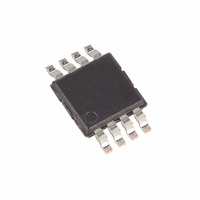MAX1679EUA+ Maxim Integrated Products, MAX1679EUA+ Datasheet - Page 8

MAX1679EUA+
Manufacturer Part Number
MAX1679EUA+
Description
IC BATT CHRGR 1CELL LITH 8-UMAX
Manufacturer
Maxim Integrated Products
Datasheet
1.MAX1679EUA.pdf
(12 pages)
Specifications of MAX1679EUA+
Function
Charge Management
Battery Type
Lithium-Ion (Li-Ion)
Voltage - Supply
5 V ~ 22 V
Operating Temperature
-40°C ~ 85°C
Mounting Type
Surface Mount
Package / Case
8-TSSOP, 8-MSOP (0.118", 3.00mm Width)
Lead Free Status / RoHS Status
Lead free / RoHS Compliant
The MAX1679 attempts to initiate fast-charge upon
insertion of the battery or application of an external
power source (current-limited wall cube). After charge
completion, charging restarts when the cell voltage
drops below 3.89V or when THERM is pulled above 1.4V.
Before a charge cycle can begin, the cell conditions
are verified to be within safe limits. The cell voltage
must be greater than 2.5V but less than the regulation
voltage (default value 4.2V). In addition, the thermistor
must indicate an acceptable cell temperature (the
default range is +2.5°C to +47.5°C). See the Appli-
cations Information section.
Li+ cells can be damaged when fast-charged from a
completely dead state. Moreover, a fully discharged
cell may indicate a dangerously abnormal cell condi-
tion. As a built-in safety feature, the MAX1679
precharges the Li+ cell with 5mA at the start of a
charge cycle when the cell voltage is below 2.5V.
Typically, 5mA is sufficient to bring a fully discharged
1000mAh Li+ cell up to 2.5V in less than 5 minutes. As
soon as the cell’s voltage reaches 2.5V and all the
other prerequisites are met (see the Fast-Charge sec-
tion), the MAX1679 begins fast-charging the cell.
If the temperature is outside the programmed range,
the charger waits. Once all prequalification conditions
are met, the charging cycle and timers begin. The
MAX1679 continues to monitor these conditions
throughout the charging cycle.
Once all cell conditions are determined to be satisfac-
tory, the MAX1679 begins fast-charging the Li+ cell by
turning on the external PMOS FET. The cell charging
current is set by the current limit of the external
power supply; it is not regulated by the MAX1679. The
PMOS FET is used as a simple switch, not as a linear
regulator. Therefore, the circuit’s power dissipation is
minimized, permitting rapid charge cycles with minimal
heat generation. The external power supply should
have a specified current limit that matches the desired
fast-charge current for the Li+ cell.
Fast-charge continues until one of the following condi-
tions is reached: 1) cell voltage climbs to the battery
regulation voltage (4.2V or as set by ADJ); 2) the fast-
charging timer expires (fault condition); or 3) cell tem-
perature rises above +47.5°C or falls below +2.5°C. If
the cell temperature moves outside the specified limits,
charging is suspended but not terminated. All timers are
paused and charging resumes when the temperature
returns to the normal range.
Single-Cell Li+ Battery Charger
for Current-Limited Supply
8
_______________________________________________________________________________________
Detailed Description
Initiating a Charge Cycle
Fast-Charge
In the most common case, where fast-charge is termi-
nated because the battery regulation voltage has been
reached (that is, the cell is nearly fully charged), the
MAX1679 will top off the cell. The MAX1679 uses a hys-
teretic algorithm with minimum on-times and minimum
off-times (Table 3). The cell voltage is sampled every
2ms. If the cell voltage (at BATT) is less than the battery
regulation voltage, the external PMOS FET turns on or
remains on. If the cell voltage is greater than, or equal
to, the battery regulation voltage, the FET turns off or
remains off until the next sample. By also measuring
the cell voltage when the PMOS FET is off, the
MAX1679 eliminates voltage errors caused by charging
current flowing through the series resistance of protection
switches or fuse links that may be in the charging path.
At the beginning of this top-off state, the current stays
on for many consecutive cycles between single off peri-
ods. As the cell continues to charge, the percentage of
time spent in the “current-on” mode decreases. Toward
the end of top off, the current stays off for many cycles
between single “on” pulses. During these final pulses,
the instantaneous cell voltage may exceed the battery
regulation voltage by several hundred millivolts, but the
duration of these pulses is several orders of magnitude
shorter than the intrinsic chemical time constant of Li+
cells. This does not harm the cell. Cell top off is com-
pleted either when the duty ratio of “on” cycles to “off”
cycles falls below 1/64 to 1/256 as set by TSEL (see
Table 3), or when the charging timer expires.
When the charge cycle is complete, the MAX1679
replaces current drawn by the BATT pin (to sense bat-
tery removal) with a 5mA (nominal) switched current.
This current is turned on and off by an on-chip com-
parator as needed to maintain the battery regulation
voltage. The cell is maintained in this manner as long
as the battery is inserted and power is connected. This
cancellation current is turned off when the MAX1679 is
shut down. Note that BATT draws less than 1µA from
the battery when power is removed.
CHG indicates the cell’s charging status. An LED can
be connected directly from IN to CHG for a visible indi-
cator. Alternatively, a pull-up resistor (typically 100kΩ)
from a logic supply to CHG provides a logic-level output.
Table 2 relates the status of the CHG to the condition of
the charger.
Switched 5mA Cancellation Current
Charge Status with CHG
Pulsed Top-Off Charge











